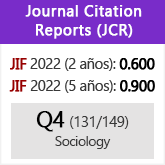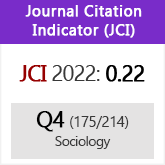Producción y percepción de bienes públicos en la lógica de la acción colectiva
DOI:
https://doi.org/10.3989/ris.2007.i46.3Palabras clave:
Teoría de Juegos, Grupos de Intereses, Dilema del Prisionero, Bienes Comunales, Bienes Colectivos, Oferta conjuntaResumen
Bienes públicos con distintas propiedades generan problemas diferentes de acción colectiva. Esta hipótesis ha sido discutida, desde distintas perspectivas analíticas, con el objeto de profundizar teóricamente sobre la lógica de la acción colectiva. En este trabajo se revisan las aportaciones recientes a esta cuestión, analizando sus puntos de encuentro y sus divergencias en cuanto a conceptos y resultados esperados. Asimismo, se examina la relación entre tipos distintos de bienes públicos y el comportamiento interdependiente de los individuos. Con este fin, los vínculos entre las funciones de producción y las formas de consumo de bienes públicos también son considerados, ya que permite desarrollar modelos más ambiciosos sobre la lógica de la acción colectiva. Finalmente, se considera la existencia de posibles problemas de percepción en los individuos que participan en la acción colectiva, produciendo desviaciones sistemáticas en la racionalidad de las decisiones, lo que nos permite concluir que, en lugar de pretender una teoría que incluya todos los problemas de la acción colectiva, deberíamos identificar patrones sistemáticos de comportamiento, susceptibles de ser contrastados empíricamente.
Descargas
Citas
Agrawal, V.K. y C. Dupont (1999), “Goods, games and Institutions”, International Political Science Review, vol. 20, nº 4, pp. 393-409. doi:10.1177/0192512199204005
Aggarwal, V.K. y C. Dupont (2003), “Comment on ‘Common Goods, Matrix Games and Institutional Response”, European Journal of International Relations, vol. 9, nº 3, pp. 1475-478.
Axelrod, R. (1984), The evolution of Cooperation, Nueva York, Basic Books.
Chamberlin, J. (1974), “Provision of Collective Goods as Function of Group Size”, American Political Science Review, vol. 68, nº 2, pp. 707-16. doi:10.2307/1959515
Cornes, R. y S. Ted (1996), The Theory of Externalities, Public Goods and Club Goods, Cambridge, Cambridge University Press.
Esteban, J. y D. Ray (2001), “Collective Action and the Group Size Paradox”, American Political Science Review, vol. 95, pp. 663-672. doi:10.1017/S0003055401003124
Hardin, R. (1971), “Collective Action as an Agreeable N-Prisoners’ Dilemma”, Behavioural Science, vol. 16, pp. 472-81. doi:10.1002/bs.3830160507
Heckathorn, D.D. (1996), “The Dynamics and Dilemmas of Collective Action”, American Sociological Review, vol. 61, nº 2, pp. 250-277. doi:10.2307/2096334
Heckathorn, D.D. (2002), “Development of a Theory of Collective Action: From the Emergence of Norms to AIDS Prevention and the Analysis of Social Structure”, en J. Berger y M. Zelditch (eds), New Directions in Sociological Theory: Growth of Contemporary Theories, San Diego, Rowman and Littlefield.
Hess, C. (2000) (comp.), “Bibliographies from the Workshop Library: Tragedy of the Commons”, http://www.indiana.edu/~workshop/wsl/tragedy.html.
Hirshleifer, J. (1983), “From Weakest-Link to Best Shot: the Voluntary Provision of Public Goods”, Public Choice, vol. 41, nº 3, pp. 371-386. doi:10.1007/BF00141070
Holzinger, K. (2003), “Reply to Aggarwal and Dupont’s Comment to The Editor”, European Journal of International Relations, vol. 9, nº 2, pp. 173-212. doi:10.1177/1354066103009002002
Holzinger, K. (2003), “Common Goods, Matrix Games and Institutional Response”, European Journal of International Relations, vol. 9, nº 2, pp. 173-212. doi:10.1177/1354066103009002002
Holzinger, K. (2001), “Aggregation Technology of Common Goods and its Strategic Consequences. Global Warming, Biodiversity, and Sitting Conflicts”, European Journal of Political Research, vol. 40, pp. 117-38. doi:10.1111/1475-6765.00592
Jones, P. (2004), “All for One and One for All’: Transactions Cost and Collective Action”, Political Studies, vol. 52, pp. 450-468. doi:10.1111/j.1467-9248.2004.00490.x
Jordana, J. (1992), Els limits de la hipotesi de racionalitat com a Jonament per a les teories de l’accio, Barcelona, Publicacions UB.
Marwell, G. y P. Oliver (1993), The Critical Mass in Collective Action: A Micro-Social Theory, Cambridge, Cambridge University Press.
Mercer, J. (2005), “Prospect Theory and Political Science”, Annual Review of Political Science, vol. 8, pp. 1-21. doi:10.1146/annurev.polisci.8.082103.104911
Oliver, P.E. y G. Marwell (2001), “Whatever Happened to Critical Mass Theory? A retrospective and Assessment”, Sociological Theory, vol. 19, nº 3, pp. 292-311. doi:10.1111/0735-2751.00142
Olson, M. (1965), The Logic of Collective Action: Public Goods and the Theory of Groups, Cambridge, MA, Harvard University Press.
Ostrom, E. (1990), Governing the Commons. The Evolution of Institutions for Collective Action, Nueva York, Cambridge University Press.
Ostrom, E. (2005), Understanding Institutional Diversity, Princeton, NJ, Princeton University Press.
Ostrom, E. (2003), “How types of goods and property rights jointly affect collective action”, Journal of Theoretical Politics, vol. 15, nº 3, pp. 239-270. doi:10.1177/0951692803015003002
Ostrom, E., R. Gardner y J. Walker (1994), Rules, Games, and Common-Pool Resources, Ann Arbor, University of Michigan Press.
Pecorino, P. y A. Temini (2004), “Olson’s Logic Revisited: The Role of Small Fixed Costs of Participation”, Working Paper Series–Economics, Finance and Legal Studies, University of Alabama.
Rapoport, A. (1988), “Experiments with N-Person Social Traps I: Prisoner’s Dilemma, Weak Prisoner’s Dilemma, Volunteer’s Dilemma, and Largest Number”, Journal of Conflict Resolution, vol. 32, nº 1, pp. 457-472. doi:10.1177/0022002788032003003
Runge, F. C. (1984), “Institutions and the Free Rider: The Assurance Problem in Collective Action”, Journal of Politics, vol. 46, nº 1, pp. 154-181. doi:10.2307/2130438
Sandler, T. (1992), Collective Action. Theory and Applications, Ann Arbor, University of Michigan Press.
Schelling, T.C. (1973), “Hockey Helmets, Concealed Weapons and Daylight Savings: A Study of Binary Choices with Externalities”, Journal of Conflict Resolution, vol. 17, nº 3, pp. 381-428. doi:10.1177/002200277301700302
Snidal, D.J. (1985), “Coordination versus Prisoner’s Dilemma: Implications for International Cooperation and Regimes”, vol. 79, pp. 923-942.
Szlagyi, M.N. (2000), “Quantitative Relationships between Collective Action and Prisioners’ Dilemma”, Systems Research and Behavioural Science, vol. 17, pp. 65-72. doi:10.1002/(SICI)1099-1743(200001/02)17:1<65::AID-SRES272>3.0.CO;2-U
Taylor, M. (1987), The Possibility of Cooperation, Nueva York, Cambridge University Press.
Taylor, M. y H. Ward (1982), “Chickens, Whales and Lumpy Goods: Alternatives Models of Public Goods Provision”, Policy Studies, vol. 30, pp. 350-70. doi:10.1111/j.1467-9248.1982.tb00545.x
Descargas
Publicado
Cómo citar
Número
Sección
Licencia
Derechos de autor 2007 Consejo Superior de Investigaciones Científicas (CSIC)

Esta obra está bajo una licencia internacional Creative Commons Atribución 4.0.
© CSIC. Los originales publicados en las ediciones impresa y electrónica de esta Revista son propiedad del Consejo Superior de Investigaciones Científicas, siendo necesario citar la procedencia en cualquier reproducción parcial o total.Salvo indicación contraria, todos los contenidos de la edición electrónica se distribuyen bajo una licencia de uso y distribución “Creative Commons Reconocimiento 4.0 Internacional ” (CC BY 4.0). Puede consultar desde aquí la versión informativa y el texto legal de la licencia. Esta circunstancia ha de hacerse constar expresamente de esta forma cuando sea necesario.
No se autoriza el depósito en repositorios, páginas web personales o similares de cualquier otra versión distinta a la publicada por el editor.

















